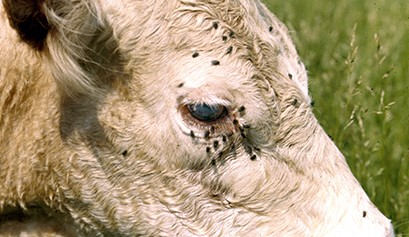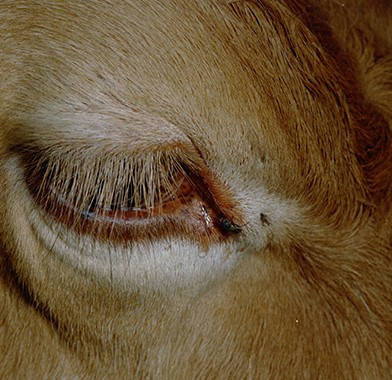By Patrick Wagner

Figure 1. Face flies clustering around the eye of a cow.
In South Dakota, the number of pinkeye cases in cattle herds has been relatively high this year. Pinkeye is a disease that occurs when the bacterial agent Moraxella bovis adheres to the surface of an animal’s eye. M. bovis gains entry when the eye becomes irritated by a variety of different sources, such as dust, tall grass, fomites, and flies. Face flies (Musca autumnalis) are one of the key contributors of pinkeye transmission in cattle (Figure 1). The wet summer experienced throughout much of South Dakota has led to an increase in fly numbers, including face flies. Proper management of these fly populations reduces the number of potential vectors and the incidence of pinkeye may be minimized.
Profile
Face flies are quite small, only about ¼ of an inch long. They are mostly gray in color with 4 black stripes that run down the back of their thorax (segment directly behind the head). Unlike many other flies that affect cattle, face flies do not have biting mouthparts. Instead, they have sucking mouthparts that they use to feed on ocular and nasal secretions. For this reason, face flies primarily attack the head, including the eyes (Figure 2), nose, and mouth.
Face flies lay their eggs in manure or decaying organic matter where the larvae, or maggots, feed and develop into adults. The development process only takes about 2 weeks, depending on environmental conditions. Their rapid life cycle allows face fly populations to build up very quickly during the hot summer months.

Figure 2. Face fly feeding on the ocular secretions around a cow’s eye.
Management
Options for managing face flies include sprays, dust bags, oilers, insecticidal ear tags, injections/pour-ons, and oral larvicides. Insecticide sprays are good for controlling adult flies, although they usually need to be applied multiple times throughout the season. Dust bags and oilers work in a similar way but require time spent checking and repairing the bags.
Click here to see more...